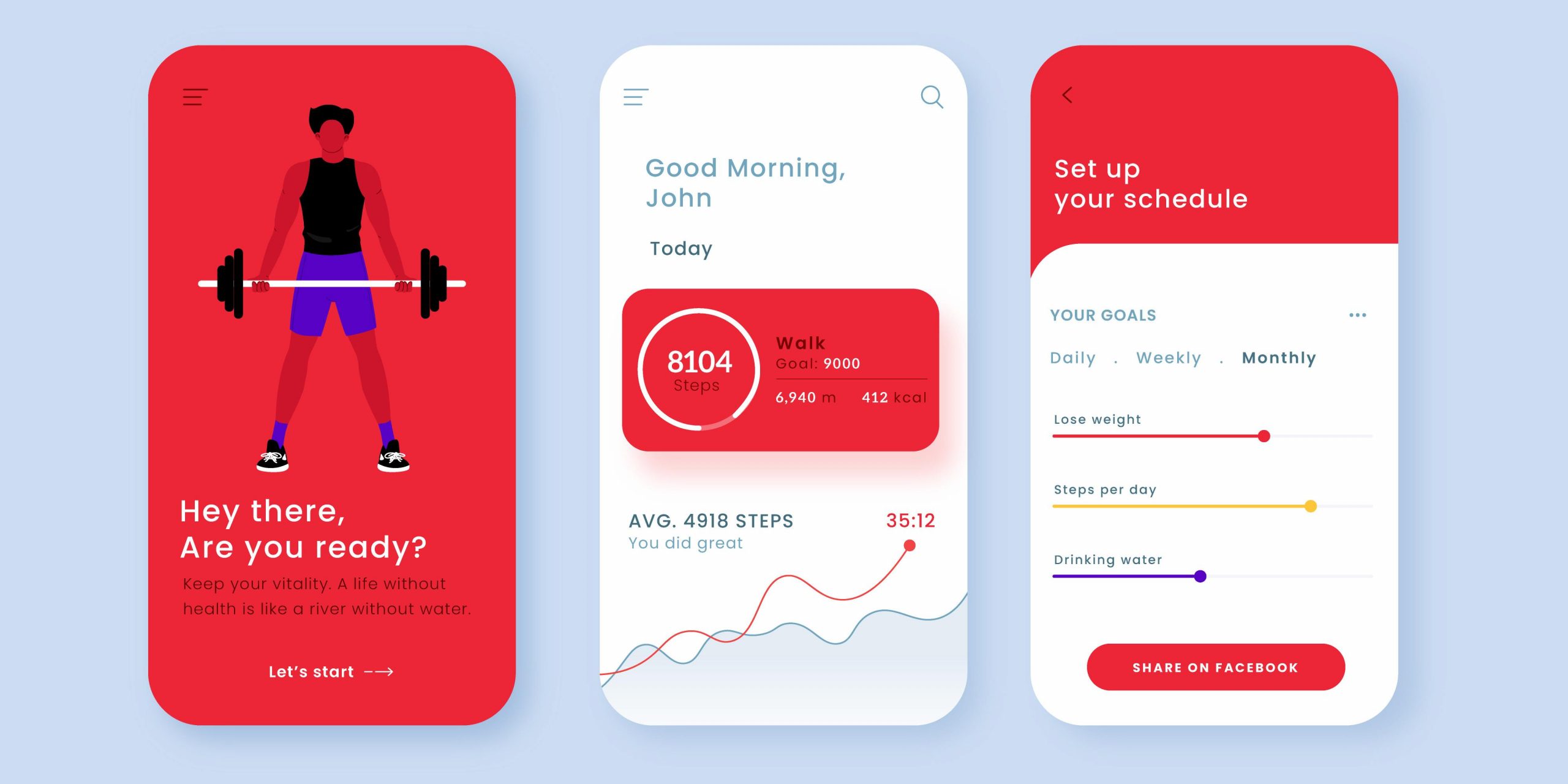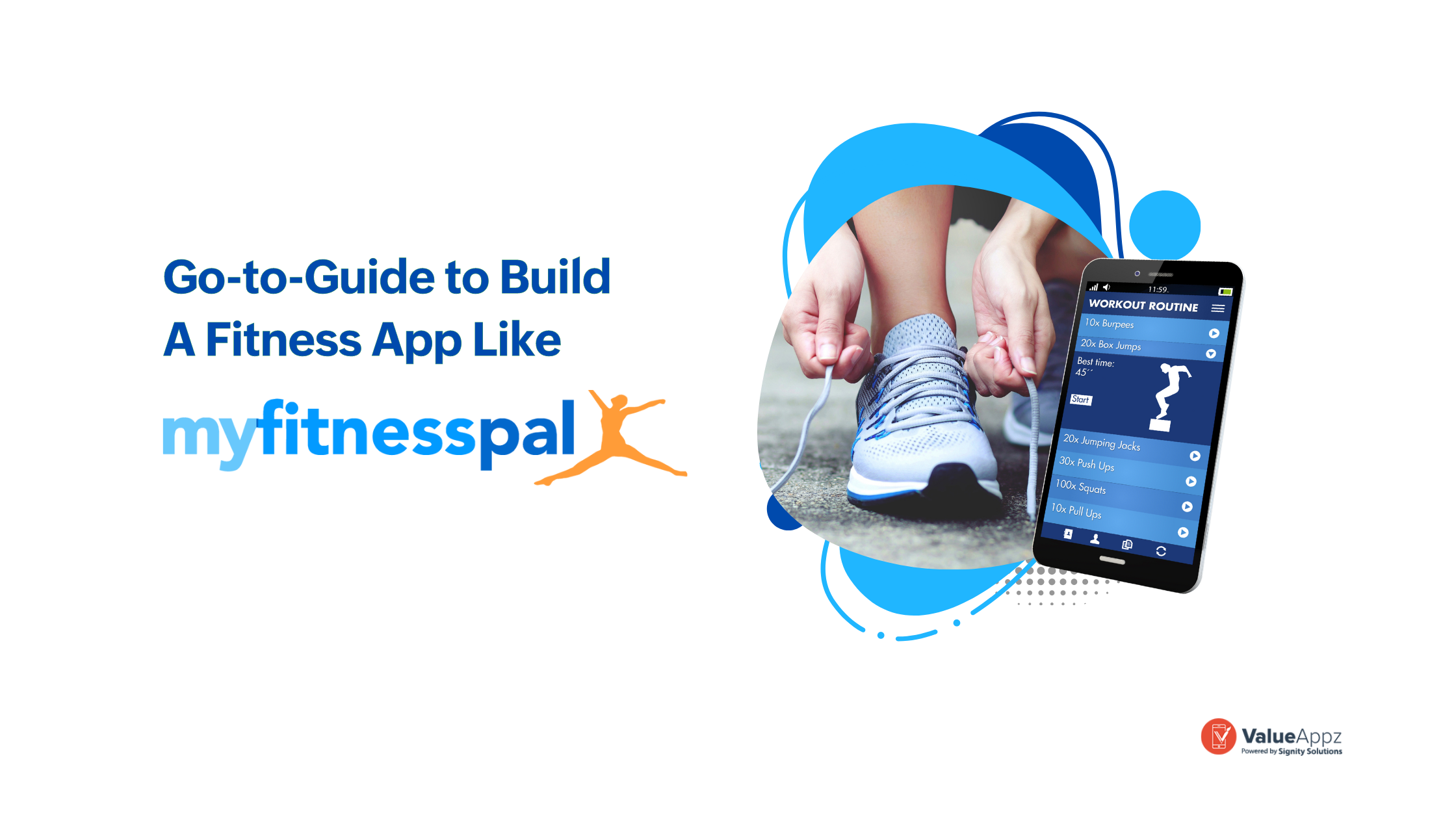Fitness App Development: Latest Features, Trends, And Costs In 2024

Summary: Want to build a fitness app that engages the users with interesting features? Here is your complete guide for fitness mobile app development where you will discover the latest features, trends, and the cost for fitness app development.
Did you know, fitness apps have over 858 million downloads? These numbers show that there is a great opportunity for the startups and small businesses to build a fitness app and enter the market of millions.
Earlier, when people had no access to technology, the only way to exercise was to visit a professional for training. With the evolution of the tech stack and the introduction of fitness app development, staying fit has become easier than ever.
Hence, you can invest in various fitness apps like personal trainer apps, gym fitness apps, meditation apps, etc. with the help of a leading fitness mobile app development company.
This blog is your complete guide to the latest features, fitness app trends, and the cost of fitness app development.
The section below will explain the must-have features of a successful fitness app.
Table of Contents
Features to Add When Building a Fitness App
A fitness app consists of users, service providers, and admin. Hence, when you plan for fitness app development, you need to build an app for all three. These apps should be engaging, attractive, and user-friendly so that they can meet all their demands.
For instance, the users would want to quickly search for the services like diet, particular exercise’ demo, or consult a professional, so the app must have all these categorized well to ensure that they get a good user experience. Similarly, service providers should be able to list their services, make fast changes, and communicate with their customers.
Remember that these features should be designed to provide an excellent experience without making it difficult for the users to navigate from one feature to another. Adding unique and eye-catching icons can make the features even more appealing.
User App
1. Quick User Registration and Profile Creation
One of the features that attract users is the quick registration process. It should include minimal steps and must allow the users to create their profiles with various social media profiles.
2. Personalized Fitness Plan
The fitness app should be designed for each user. It should provide tailored workout plans based on user profiles, goals, and fitness levels. This feature will further enhance the user engagement and retention.
3. Activity Tracking
Another reason why users prefer fitness apps is their ability to track their activities. Adding this feature will enable users to track steps, running, cycling, and swimming, making the app even more useful.
4. Nutrition and Meal Planning
A number of fitness apps also enable users to get personalized nutrition and meal plans based on their personal preferences. Hence, when building a gym fitness app or personal trainer app, you can add this feature.
5. Workout Videos and Tutorials
Whether you want to build a yoga app, gym app, or personal trainer app, adding the feature for workout videos and tutorials is an amazing way to grab the attention of the audience and keep them engaged.
6. Progress Tracking and Analytics
Adding this feature during fitness application development is crucial. This feature should include various metrics like weight, BMI, workout consistency, and improvements.
7. Push Notifications and Reminders
This feature is a great way to remind the app users about upcoming plans, sessions, progress milestones, and daily health tips. With engaging push notifications, you can grab the attention quickly.
8. In-App Purchase and Subscriptions
You can also offer premium content, advanced features, and exclusive access through in-app purchases and subscription models. Further, smooth and secure payment methods should be added.
9. Integration with Social Media
Integration with social media is a must to allow users to share their achievements and progress on various platforms. It can further attract new customers and expound your fitness app awareness.
10. Advanced Features with AI and ML
Leverage Artificial Intelligence and Machine Learning to provide smart recommendations, predict user needs, and offer personalized feedback.
11. Community Features
Build a community with forums, groups, and challenges. Your fitness app must allow users to share achievements, participate in group challenges, and support each other.
12. Workout Logging
Enable users to log their workouts, including exercise type, duration, intensity, and calories burned. Offer insights and progress tracking.
Service Provider App
1. Service Provider Profile and Verification
Allow service providers to create comprehensive profiles showcasing their qualifications, specialties, experience, and certifications with a quick verification process.
2. Service Listing and Customization
Your fitness app must also allow service providers to list their services easily for better engagement and provide an option to customize these whenever needed.
3. Appointment Scheduling and Management
You can also integrate a calendar for the service providers to manage their appointment schedules with their clients.
4. Client Management
The fitness app should also allow the service providers to manage their client’s profiles, including their fitness goals, progress, and preferences. They should also be able to communicate with them through messages and video calls.
5. Content Upload and Management
This feature should enable the service providers to upload workout videos, tutorials, diet plans, and other resources. You can also include a CMS to help organize and update their content.
6. Analytics and Reporting
The analytics and reporting feature in the fitness app should help service providers track session attendance, client progress, and overall performance. It must also generate reports for better analytics.
7. Payment Management
The payment management feature should facilitate secure in-app payments and allow providers to track their earnings, manage invoices, and handle transactions.
8. Group Class Management
Enable providers to schedule and manage group classes while tracking attendance and participant lists efficiently.
9. Community Engagement
Facilitate community engagement for providers through forums, groups, events, and webinars to share knowledge, discuss best practices, and stay updated with industry trends.
10. Feedback and Reviews
Enable a rating system for clients to review service providers and provide tools for providers to respond to and address feedback.
Now that you know how you can make the fitness app more engaging with the features and functionalities, the next section will explain the fitness app development cost.
Cost Of Developing a Fitness App
When thinking about building a fitness app, entrepreneurs usually have the question- “How much does it cost to build a fitness app?” Health and fitness app development requires a professional team with extensive experience, top-notch technology, an understanding of the latest trends, and time to build a quality app. The average cost of app development can vary from $15,000-$60,000.
The cost can further vary based on the below factors:
- Platform: The cost of developing an app for one platform, such as iOS or Android, is typically lower than developing for multiple platforms simultaneously.
- Features: The complexity of the features you want to include in your health and fitness app will significantly impact the cost of development. Features such as workout tracking, personalized training plans, social sharing, and gamification will all add to the price.
- Design: The design of the app can also impact the development cost. Custom designs and animations will require more time and effort, translating to higher prices.
- Third-party integrations: If you want your app to integrate with other third-party services or devices, such as wearable technology or fitness tracking apps, this will increase the development cost.
- Backend development: If your app requires a backend infrastructure, such as a server or database, this will add to the development cost.
- Testing and quality assurance: Ensuring that the app is bug-free and user-friendly requires thorough testing and quality assurance, which can add to the overall development cost.
- Location of the development team: The location of the development team can also directly impact the cost. Hiring a team from a developed country with a higher cost of living will generally be more expensive than hiring a team from a developing country.
- Timeframe: The timeframe for developing the app will also impact the cost. Rushing development may increase the cost, while a longer development timeline may reduce the cost.
Latest Fitness App Trends You Must Follow During The App Development
What does it take to build a fitness app that is unique and can easily attract the target market? One thing that needs to be carefully considered is the latest market trends for fitness app development. These trends are set based on the changing demands of the customers and the solutions they are seeking. Some of the trends that you must follow in 2023 are:
a) Wearable Integration Is An Unskippable Part
92% of smartwatch users use them for health and fitness reasons. About 88% said that wearable technology helped them achieve their fitness goals. These studies clearly show that integrating wearable devices with fitness apps is the hottest trend. This technology is a must-have in fitness app development, from reminding users to consume sufficient water to sending personalized notifications, keeping a record of their calorie intake, etc.
b) Personalized Solutions For Each User
Whenever we talk about building an app, personalization cannot go unnoticed. Especially in health and fitness app development, every user has different goals and targets to achieve. A quality app should track the daily activities, food intake, and other aspects for which the customer has downloaded the application.
Also, sending personalized messages like met targets and daily reminders can make the app even more helpful.
c) Online Sessions With Professionals
Nowadays, users also download the app to consult professionals for their health and fitness needs. For example, a user may consult a gym trainer online to plan the diet. Further, some users might want to attend virtual classes for gym, meditation, and yoga.
Hence, your fitness app should allow customers to participate in online sessions or consult a professional.
d) Gamification Pulls in More Customers
Gamification is another trend that helps engage users and pull in Gen Z and Millennials. If studies are to be believed, 52.5% of fitness apps on the App Store contain at least one gamification element. In fitness app development, gamification is the process of using game-inspired elements in training.
Gamification features, such as rewards, badges, and points, are used to make fitness fun and engaging for users.
e) VR and AR For Mesmerizing Experiences
Virtual Reality (VR) and Augmented Reality (AR) are entering the fitness space by providing immersive and engaging workout experiences. VR can transport users to virtual environments, such as a beach or mountain trail, while they exercise, making the workout more enjoyable and motivating. On the other hand, AR can overlay digital information in the real world, such as workout instructions or virtual trainers, to help users perform exercises more accurately.
Both technologies also have the potential to provide personalized feedback and tracking of user performance, enhancing the overall fitness experience.
Work With ValueAppz- A Top Fitness App Development Company
ValueAppz is a leading fitness mobile app development company, and we have helped over 500+ global clients. Our developers work with the latest technologies like React, Node, and Next.js to build innovative solutions.
Get in touch with us or book a consultation with an expert to bring your app idea to life with the best solutions.
Key Takeaways
- Growing Market Potential: With over 858 million fitness app downloads, the market presents a significant opportunity for startups and small businesses to thrive.
- Essential Features: Successful fitness apps should include features like personalized fitness plans, activity tracking, nutrition planning, workout videos, and integration with social media for enhanced user engagement.
- Service Provider Capabilities: Fitness apps must empower service providers with tools for client management, content upload, appointment scheduling, analytics, and secure payment handling to streamline their operations.
- Cost Factors: Developing a fitness app typically costs between $25,000 and $50,000, influenced by platform choice, feature complexity, design, third-party integrations, backend development, and the development team’s location.
Frequently Asked Questions
Q1. How much would it cost to develop a fitness app?
The cost of fitness app development can vary from $15,000 to $60,000. This cost can further depend on factors like app design, features and their complexity, platforms, tech stack, and the fitness app development company’s location, experience, and skills.
Q2. What are the trends in fitness apps?
Some of the latest trends in fitness apps are wearable integration, AI and ML, online sessions, personalized solutions, AR and VR, and gamification to enhance the customer experience.
Q3. What is the future scope of fitness apps?
The future scope of fitness apps is incredible. With more and more people getting fitness conscious, the demand for fitness apps is yet to see more growth.
Q4. What features should be in the fitness app?
Some features that you must add to the fitness app are quick registration, social media integration, client management, in-app purchases, and progress tracking.
Q5. What makes a fitness app successful?
To make the fitness app successful, you must add the best features, make the interface easy, design the app well, integrate the app with the latest trends, and provide personalized solutions to the users.
💡 Editor’s Note: This blog entry was originally published on April 27, 2023, and is updated on May 27, 2024
THE AUTHOR
Harjyot kaur
As a technical content writer my focus is on creating high-quality, engaging, and informative content that simplifies complex technical topics. Throughout my career, I have continuously pursued opportunities for growth and development, refining my skills and expanding my knowledge base.

Get ready to digitally transform your business.
Let our team help take your business to the next level. Contact us today to get started on finding the perfect solutions for your business needs.










